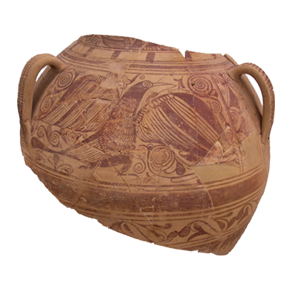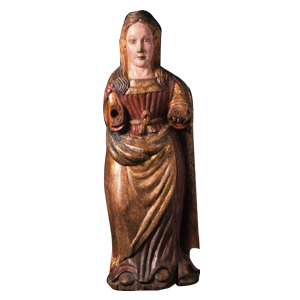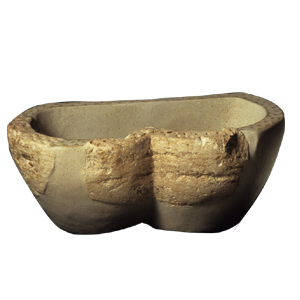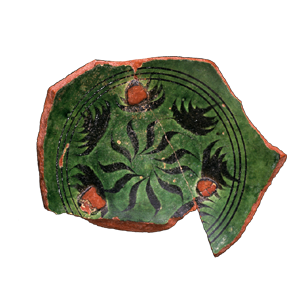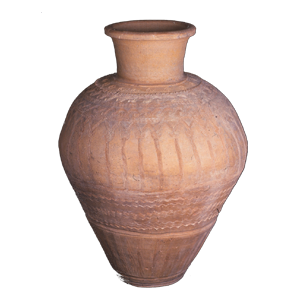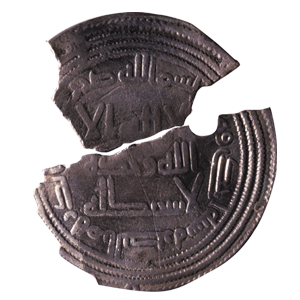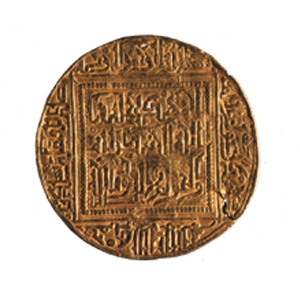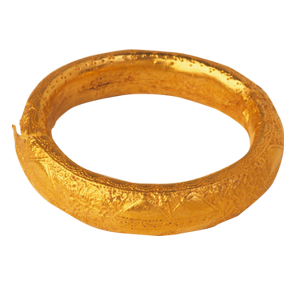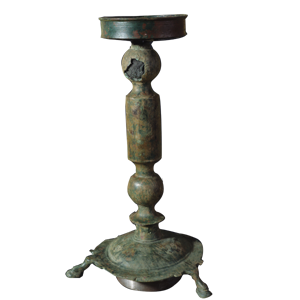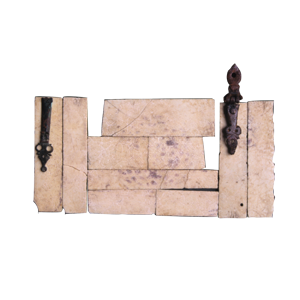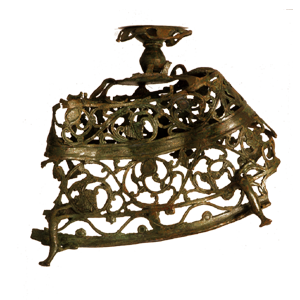
Openwork lamp with phytomorphic decoration
C/ Historiador Palau, Denia Bronze h: 21 cm; w: 26 cm; Fatimid Islamic 2nd ½ c. 10th c.
An incomplete lamp with part of its base missing and its body completely flattened. Its original shape is truncated cone-shaped. It rests on three legs, only two of which have survived; these are in the shape of animals, possibly lions. The decoration on the main body is structured in two parallel bands separated by a plain band. The bands are decorated with the same plant motif as the Tree of Life, arranged in a border of circling tendrils that alternately enclose leaves, apples, bunches and sometimes trifoliate leaves. The lamp has a tulip-shaped finial with a projecting rim and rectangular perforations. This finial is linked to the body by means of bundles of double stems. The work is made in lost wax using a refined fretwork technique.
The formal resemblance to the large incense burner in the Louvre Museum (PARIS, 1977, no. 19) dated to the 9th century: its upper part is formally very similar to our lamp, as is the presence of the legs of a zoomorphic figure, in this case hares; the development of the phytomorphic motif, with bundles of stems encircling the trifoliate leaves and clusters, etc., all point to the profound and intense Coptic influence of the work.
CS: 7699
AZUAR, R., 1989.
Highlights of the Middle Ages Room
- TINAJA CON DECORACIÓN
ESTILO ELCHE-ARCHENA
Tossal de la Cala (Finestrat).
Cerámica
h: 39 cm; a: 46 cm; e: 30 cm
Iberian
Siglos II-I a.C. - ................................................. Fondo Histórico MARQ Carving on wood and polychrome on canvas covered with a layer of plaster h: 94.5 cm; w: 30 cm; d: 23 cm: 30 cm; w: 23 cm Late Gothic First half of the 16th century
- ................................................. Castell d'Ambra, (Pego) Travertine marble h: 35.8 cm; w: 20 cm; h: 18.5 cm Of Islamic origin and Christian reuse 1250-1280
- ................................................. Rambla Méndez Nuñez (Alicante) Ceramic h: 16.3 cm; w. 4.4 cm: 4,4 cm Italian import End of the 15th century - Beginning of the 16th century
- ................................................. Church of Santa María (Alicante) Ceramic h: 90 cm; w: 63 cm Late Gothic Mid-15th century
- ................................................. Finca "La Marquesa" (Almoradí) Caliphate Silver Mid-11th century AD.
- ................................................. Numismatic Fund MARQ Gold d: 2'8 cm; p: 4'65 gr; p.c.:12 h. Medieval Islamic Hafsid. Tunisia 1249-1277
- ................................................. Castillo del Río (Aspe) Gold leaf h: 1.8 cm; d: 7.6 cm Islamic Mudejar 13th century
- ................................................ C/ Historiador Palau, Denia Bronze h: 47'5 cm; d: 26 cm Fatimid Islamic 11th century
- ................................................. C/ Historiador Palau, Denia Bronze h: 21 cm; w: 26 cm; Fatimid Islamic 2nd ½ c. 10th c.
- ................................................. Torre Grossa Castle (Jijona) Reconstructed chest with bone plates and metal ornaments h: 26 cm; w: 11 cm; d: 10 cm (restored) Islamic Almohad Late 12th century, first half of the 13th century

